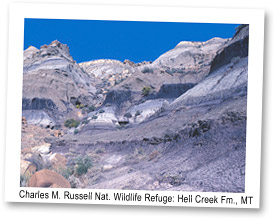|
Online exhibits : Special exhibits : Fossils in our parklands
Charles M. Russell National Wildlife Refuge, U.S. Bureau of Reclamation, Bureau of Land Management: The Hell Creek Formation, Montana
by Mark Goodwin
The "badlands" of this area of northeastern Montana provide an "outdoor laboratory" in which to explore — a paleontologist's dream. It is perhaps best known for the highly fossiliferous Hell Creek Formation exposed primarily on state and federal lands and composed of freshwater clays, mudstones and sandstones deposited during the last part of the Cretaceous, the Maastrichtian period. The formation has produced important assemblages of invertebrates, plants, mammals, fish, reptiles, and amphibians, providing an impressive inventory that includes dinosaurs such as Tyrannosaurus and Triceratops. |
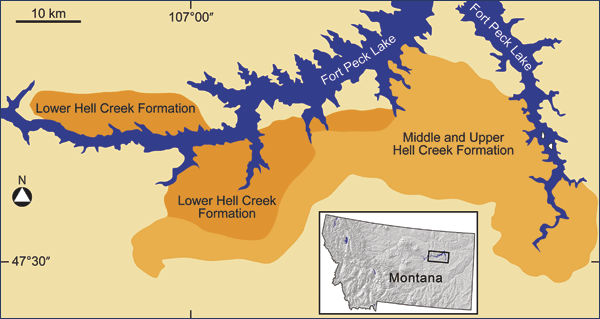

A map showing the extent of the Hell Creek Formation. |
UCMP involvement
The Hell Creek Project (1999-2010), a collaborative, multi-institutional field study program, was organized by Jack Horner (Museum of the Rockies, Bozeman, MT), UCMP's Bill Clemens and Mark Goodwin, Joseph Harman (University of North Dakota), and colleagues from around the country. The overall goal of the project was to create a comprehensive biotic foundation from which paleobiological and geological hypotheses could be tested. Graduate students were trained and many completed their fieldwork instrumental to their thesis and dissertation studies. This work continues today as these newly minted doctoral students advanced to the next level in teaching positions with graduate students of their own, such as Greg Wilson, Bill Clemens' former graduate student, now at the University of Washington.
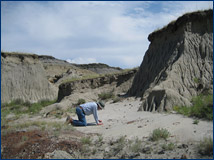 |
 |
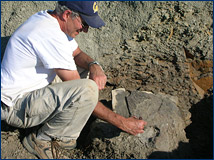 |
 |
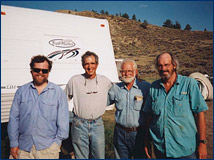 |

Click on any image to see an enlargement. Left: Bill Clemens looks for microfossils in the Hell Creek Formation. Middle: Mark Goodwin collects a juvenile Triceratops skull found weathering out of the Late Cretaceous Hell Creek Formation. Right: Hell Creek Project participants Mark Goodwin, Bill Clemens and Jack Horner are joined by project supporter Nathan Myhrvold (left). |
One of the many projects included the collection of dinosaur specimens to test hypotheses focused on their relative abundance and the presence or absence of various dinosaurian ontogenetic stages. These dinosaurs and all associated fossils collected were deposited in the Museum of the Rockies and the UC Museum of Paleontology where they are conserved in perpetuity for the public trust. Data associated with this irreplaceable record of "life through time" and our fossil heritage are also managed and made available to qualified researchers and the public. Scientists use this information from the fossil record and sediments to investigate climate change through time, plant and animal diversity, and origination and extinction rates.
Previous Hell Creek Formation surveys attempted to statistically support particular extinction hypotheses, but offered minimal information on the actual composition of the stratigraphically dispersed assemblages through the entire section of the Hell Creek Formation. Some focused on taphonomy only, while others examined the structure of the dinosaur assemblage without regard to sedimentology and stratigraphy. Horner and Goodwin considered it essential that all temporal and spatial points of reference be considered synthetically when analyzing taxa from the fossil record — a type of unified field theory for paleontological specimens. Horner and Goodwin, assisted by the numerous field crews of students, volunteers, and paleontologists, incorporated multiple lines of evidence from geography, taphonomy, stratigraphy, phylogeny, and ontogeny to determine the relative abundance of large dinosaur skeletons preserved in the entire Upper Cretaceous Hell Creek Formation — not just the upper portion of the formation where earlier attempts to produce a dinosaur census concentrated in northeastern Montana.
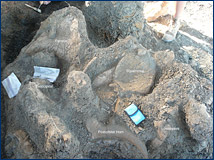 |
 |
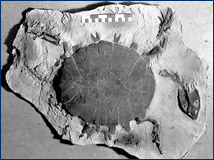 |
 |
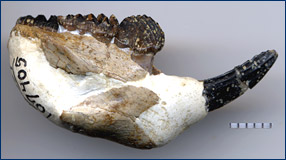 |

Click on any image to see an enlargement. Left: A block containing the disarticulated skull of a juvenile Triceratops is almost ready for its protective jacket of plaster-soaked burlap strips. Middle: Trionyx, a Late Cretaceous turtle from the Hell Creek Formation, McCone County. Right: Right dentary of the multituberculate mammal Meniscoessus robustus from the Hell Creek of Garfield County. |
In the collections
The UCMP houses an extensive collection of fossils from this area of Montana — almost 18,000 cataloged specimens are in the collections database.
Note: Collection of fossil material is illegal unless done under a permit from the appropriate Federal land management agency. If you think you have found a fossil on National Park, U.S Bureau of Reclamation, or BLM lands, please contact a Federal land management representative.
More information
Learn more about the Charles M. Russell National Wildlife Refuge.
Many citations about the Hell Creek are included in this publication by the Geological Society of America.
